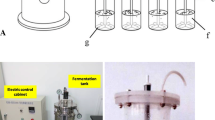Abstract
The performance of an exogenous bacterium, Methylobacterium extorquens, in inducing bioxidation of methane from landfill gas (LFG) was assessed in a laboratory scale bioreactor. The study show that enhanced oxidation of methane is attained when the bacteria are introduced into the landfill soil. The maximum percentage reduction of methane fraction from LFG when the bioreactor was inoculated with the methanotrophic bacteria was 94.24 % in aerobic treatment process and 99.97 % in anaerobic process. In the experiments with only the indigenous microorganisms present in the landfill soil, the maximum percentage reduction of methane for the same flow rate of LFG was 59.67 % in aerobic treatment and 45 % in anaerobic treatment. The methane oxidation efficiency of this exogenous methanotrophic bacterium can be considered to be the optimum in anaerobic condition and at a flow rate of 0.6 L/m2/min when the removal percentage is 99.95 %. The results substantiate the use of exogenous microorganisms as potential remediation agents of methane in LFG.








Similar content being viewed by others
References
Al-Yousfi AB, Pohland FG (1998) Strategies for simulation, design, and management of solid wastes disposal sites as landfill bioreactors. Pract Period Hazard Toxic Radioact Waste Manag 2(1):13–21
Jain P, Powell J, Townsend TG, Reinhart DR (2005) Air permeability of waste in a municipal solid waste landfill. J Environ Eng 131(11):1565–1573
Hac Ko J, Powell J, Jain P, Kim H, Townsend T, Reinhart D (2013) Case study of controlled air addition into landfilled municipal solid waste: design, operation, and control. J Hazard Toxic Radioact Waste 17(4):351–359
Stein VB, Hettiaratchi JPA, Achari G (2001) Numerical model for biological oxidation and migration of methane in soils. Pract Period Hazard Toxic Radioact Waste Manag 5(4):225–234
Bogner J, Spokas K (1993) Landfill CH4: rates, fates, and role in global carbon cycle. Chemosphere 26(1–4):369–384
Morgan SM, Yang Q (2001) Use of landfill gas for electricity generation. Pract Period Hazard Toxic Radioact Waste Manag 5(1):14–24
Spokas K, Bogner J, Chanton JP, Morcet M, Aran C, Graf C, Moreau-Le Golvan Y, Hebe I (2006) Methane mass balance at three landfill sites: what is the efficiency of capture by gas collection systems? Waste Manag 26(5):516–525
Garg A, Achari G, Joshi RC (2007) Application of fuzzy logic to estimate flow of methane for energy generation at a sanitary landfill. J Energy Eng 133(4):212–223
Albanna M, Fernandes L (2009) Effects of temperature, moisture content, and fertilizer addition on biological methane oxidation in landfill cover soils. Pract Period Hazard Toxic Radioact Waste Manag 13(3):187–195
Babilotte A, Lagier T, Fiani E, Taramini V (2010) Fugitive methane emissions from landfills: field comparison of five methods on a french landfill. J Environ Eng 136(8):777–784
Ramani T, Sprague S, Zietsman J, Kumar S, Kumar R, Krishnan A (2012) Landfill gas to energy applications in India: prefeasibility analysis of Mumbai landfills. J Hazard Toxic Radioact Waste 16(3):250–257
Ozkaya B, Demir A, Bilgili MS (2007) Neural network prediction model for the methane fraction in biogas from field-scale landfill bioreactors. Environ Modell Softw 22(6):815–822
Bogner JE, Meadows M, Czepiel P (1997) Fluxes of methane between landfills and the atmosphere: natural and engineered controls. Soil Use Manag 13(4):268–277
Borjesson G, Svensson BH (1997) Seasonal and diurnal methane emissions from a landfill and their regulation by methane oxidation. Waste Manag Res 15(1):33–54
Hilger HA, Liehr SK, Barlaz MA (1999) Exopolysaccharide control of methane oxidation in landfill cover soil. J Environ Eng 125(12):1113–1123
Abichou T, Powelson D, Chanton J, Escoriaza S, Stern J (2006) Characterization of methane flux and oxidation at a solid waste landfill. J Environ Eng 132(2):220–228
Cabral AR, Moreira JFV, Jugnia LB (2010) Biocover performance of landfill methane oxidation: experimental results. J Environ Eng 136(8):785–793
Jung Y, Imhoff PT, Augenstein DC, Yazdani R (2009) Influence of high-permeability layers for enhancing landfill gas capture and reducing fugitive methane emissions from landfills. J Environ Eng 135(3):138–146
Roncato CDL, Cabral AR (2012) Evaluation of methane oxidation efficiency of two biocovers: field and laboratory results. J Environ Eng 138(2):164–173
Yuan L, Abichou T, Chanton J, Powelson DK, De Visscher A (2009) Long-term numerical simulation of methane transport and oxidation in compost biofilter. Pract Period Hazard Toxic Radioact Waste Manag 13(3):196–202
Visvanathan C, Pokhrel D, Hettiaratchi JPA, Wu JS (1999) Methanotrophic activities in tropical landfill cover soils: effects of temperature, moisture content and methane concentration. Waste Manag Res 17(4):313–323
Chistoserdova L, Sung-Wei C, Lapidus A, Lidstrom ME (2003) Methylotrophy in Methylobacterium extorquens AM1 from a genomic point of view. J Bacteriol 185(10):2980–2987
Korotkova N, Chistoserdova L, Lidstrom ME (2002) Poly-β-Hydroxybutyrate biosynthesis in the facultative methylotroph Methylobacterium extorquens AM1: identification and mutation of gap11, gap20 and phaR. J Bacteriol 184(22):6174–6181
Corpe WA, Rheem S (1989) Ecology of the methylotrophic bacteria on living leaf surfaces. FEMS Microbiol Lett 62(4):243–249
Patt TE, Cole GC, Hanson RS (1976) Methylobacterium, a new genus of facultatively methylotrophic bacteria. Int J Syst Bacteriol 26(2):226–229
Smejkalová H, Erb TJ, Fuchs G (2010) Methanol assimilation in Methylobacterium extorquens am1: demonstration of all enzymes and their regulation. PLoS ONE 5(10):13001
Sy A, Timmers ACJ, Knief C, Vorholt JA (2005) Methylotrophic metabolism is advantageous for Methylobacterium extorquens during colonization of Medicago truncatula under competitive conditions. Appl Environ Microbiol 71(11):7245–7252
Acknowledgments
The authors express their gratitude to the Director, National Centre for Earth Science Studies, for the support extended for this work. Thanks are due to BIOTECH, Trivandrum, India, for supplying biogas needed for the study and to the Centre for Environment and Development, Trivandrum, India, for providing landfill soil and leachate from their waste management facility. The authors thank Mr. George Thomas, Research Scholar, Centre for Earth Science Studies, Trivandrum, who analysed the LFG samples for this study.
Author information
Authors and Affiliations
Corresponding author
Rights and permissions
About this article
Cite this article
Nair, D.N.K., Zachariah, E.J. & Vinod, P. Investigations on enhanced in situ bioxidation of methane from landfill gas (LFG) in a lab-scale model. J Mater Cycles Waste Manag 19, 172–179 (2017). https://doi.org/10.1007/s10163-015-0397-4
Received:
Accepted:
Published:
Issue Date:
DOI: https://doi.org/10.1007/s10163-015-0397-4




